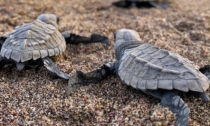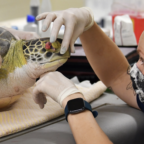
Bangladesh has recorded the highest number of olive ridley turtle eggs laid on the country’s beaches this nesting season, thanks to extensive conservation actions. A survey by the NGO Nature Conservation Management (NACOM) found 7,528 eggs at 58 spots on three different islands — Pachar, Shilkali and Shahpari — off the coastal district of Cox’s Bazar. That’s a 30% increase from the 5,763 eggs found in 54 spots in 2022, which in turn was a 22% increase from the 4,713 eggs recorded in 2021.
Of the seven sea turtle species, five occur in the waters off Bangladesh: the olive ridley turtle (Lepidochelys olivacea), green turtle (Chelonia mydas), hawksbill turtle (Eretmochelys imbricata), loggerhead turtle (Caretta caretta) and leatherback turtle (Dermochelys coriacea). Only the first three of these come ashore to nest in Bangladesh, predominantly the olive ridley turtle.
The sharp increase in recent years in olive ridley eggs being recorded on Bangladesh’s beaches is due to various comprehensive conservation initiatives being undertaken by the government, NGOs and local communities, including volunteer work, said Shafique Rahman, deputy project director of NACOM.
These include efforts to raise awareness among coastal communities about the importance of ensuring a safe environment for the turtles to lay their eggs, he added.
The olive ridley turtle is listed as vulnerable on the IUCN Red List. In the Cox’s Bazar region, adult female turtles lay their eggs on the beach in the dark of night, and the baby turtles usually hatch from November to April.
The government has initiated several actions to create a safe environment for the turtles, including setting up five conservation centers in Cox’s Bazar where eggs are incubated and hatched in a controlled environment to give the hatchlings a better chance of survival. Nesting grounds have also been set up on beaches to make it easier for the female turtles to haul themselves ashore and lay their eggs safely, said Md. Sarwar Alam, divisional forest officer for the Cox’s Bazar region.
All this is happening with the involvement of local communities, he added.


Challenges ahead to protect the species
In its 2015 national report to the Convention on Biological Biodiversity, the Bangladesh government noted that turtle nesting grounds on beaches were being destroyed due to development activities and increased tourist traffic. Turtles were also dying after being ensnared in commercial fishing nets at sea, impacting the number of nesting turtles and eggs.
According to the Department of Environment, 12 dead turtles were found on beaches in the first six months of 2020, down from 48 in 2019.
Mohammad Russell, former program officer for the Bangladesh Marine Life Alliance, said fishing with large nets is prohibited within 10 kilometers (6 miles) of St. Martin’s Beach, on the island of the same name, during the turtles’ nesting season. But in reality, fishers don’t abide by the rule.
“The green turtle can stay under the sea for a maximum of five hours, and the olive ridley is about the same. Then they have to climb up to breathe. Turtles stay close to the coast when they lay their eggs. But if caught in fishing nets, they die [if] underwater for a long time,” he said.
Once on land, however, safety isn’t guaranteed. Beaches across Bangladesh are already intense pressure for development by the tourism industry, despite a scattering of conservation efforts by NGOs and the government. At the same time, the government is promoting sectors like tourism and infrastructure development that threaten nesting turtle populations.
Russell said that due to the lights of hotels built very close to the beach and the noise of tourists, the nighttime arrival of turtles on some beaches has decreased. When they do arrive, they often leave right away without laying any eggs.

The Bangladesh government has in recent years signed several international agreements, conventions, treaties and protocols related to the marine environment and biological resources that affect marine turtles, whether directly or indirectly.
In 2016, the Department of Environment undertook a conservation project to protect turtles nesting on St. Martin’s, the country’s only coral island.
Alam, the Cox’s Bazar forest officer, said, “There is no alternative for public awareness to prevent disruption of sea turtle breeding. Besides, everyone should come forward to control the movement of people in the breeding spots and protect them from dogs and foxes.”
He also said the government continues working on turtle conservation, including expanding protection to the popular tourist area of Teknaf Beach, which is increasingly frequented by nesting olive ridley turtles.















Social Profiles